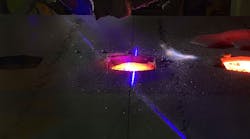As businesses and investors strive to identify the role of Artificial Intelligence in manufacturing, some operators and developers are moving forward, and finding real advantages by applying AI to existing operations – including an iron foundry.
Vald. Birn A/S in Holstebro, Denmark, one of six foundries in the BIRN Group, reports energy savings thanks to a cooperative effort with pour-tech AB to optimize the process of filling sand molds. Birn casts ferrous parts for commercial vehicle manufacturng, construction and material handling machinery, hydraulic systems, transmission systems, heavy machinery, and defense systems.
The foundry adopted pour-tech AB’s EASYpour®™ technology in 2020 as part of a collaboration with the foundry to monitor and analyze molten-metal pouring. With EASYpour, two laser beams are positioned to precisely locate a molten metal stream as it enters the mold, to control pouring in a way that is repeatable and reliable. As the stream enters the mold, sensors collect pouring performance data and software evaluates the information to continuously optimize parameters, to avoid slag build-up, variations in temperature and launder level, wear conditions for the stopper and nozzle, and similar problems that reduce dosing effectiveness.
The Birn installation offered the chance to advance the pouring technology in actual working conditions, with input from experience foundry operators.
“Our AI technology works based on data that had to be collected in the first step. In cooperation with Birn, we had the chance to fill our database with crucial information over an extended period and data to acquire knowledge before it was introduced into a production process,” said pour-tech sales manager Oliver Schmitz.
Two laser sensors monitor and analyze molten-metal pouring, while the AI function evaluates how liquid iron is dosed into the molds. Dosing is important to tracking metal heating, and consequently, energy consumption: “The technology helps us save a significant amount of energy because precise dosing into the molds is essential for determining the exact amount of energy needed to fill the molds adequately and allow the molten metal to flow perfectly into the molds,” offered Birn CTO Lars Jørgensen.
“The technology is a great aid to our operators, but it certainly cannot replace them in the whole process,” Jørgensen concluded. “It essentially serves as a skilled assistant, helping to optimize the pouring processes while operators can take samples of molten iron and perform other specialized tasks.”
Based on the energy-saving results gained from the initial application, Birn plans to expand its use of the technology for more mold-filling operations.









